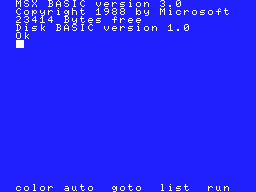Distribution

MSX BASIC came bundled in the ROM of all MSX computers. At system start-up MSX BASIC is invoked, causing its command prompt to be displayed, unless other software placed in ROM takes control (which is the typical case of game cartridges and disk interfaces, the latter causing the MSX-DOS prompt to be shown if there is a disk present which contains the DOS system files).
When MSX BASIC is invoked, the ROM code for BIOS and the BASIC interpreter itself are visible on the lower 32K of the Z80 addressing space. The upper 32K are set to RAM, of which about 23K to 28K are available for BASIC code and data (the exact amount depends on the presence of disk controller and on the MSX-DOS kernel version).